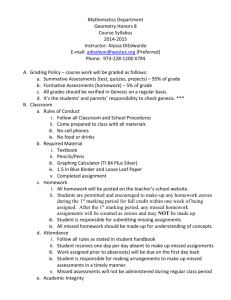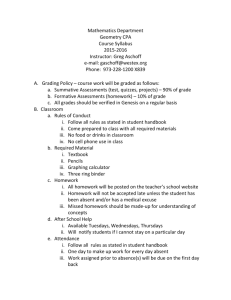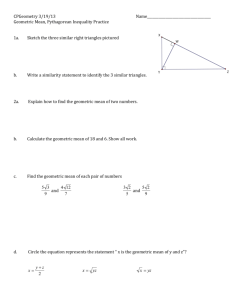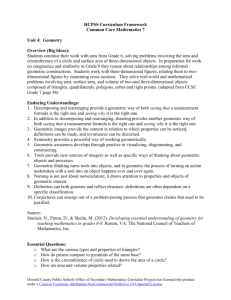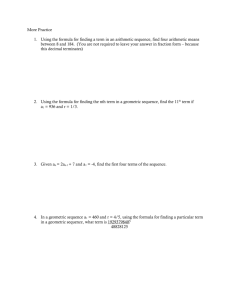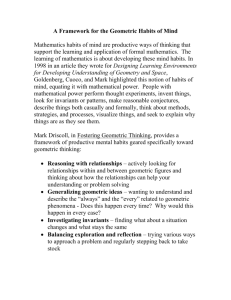Geometry
advertisement
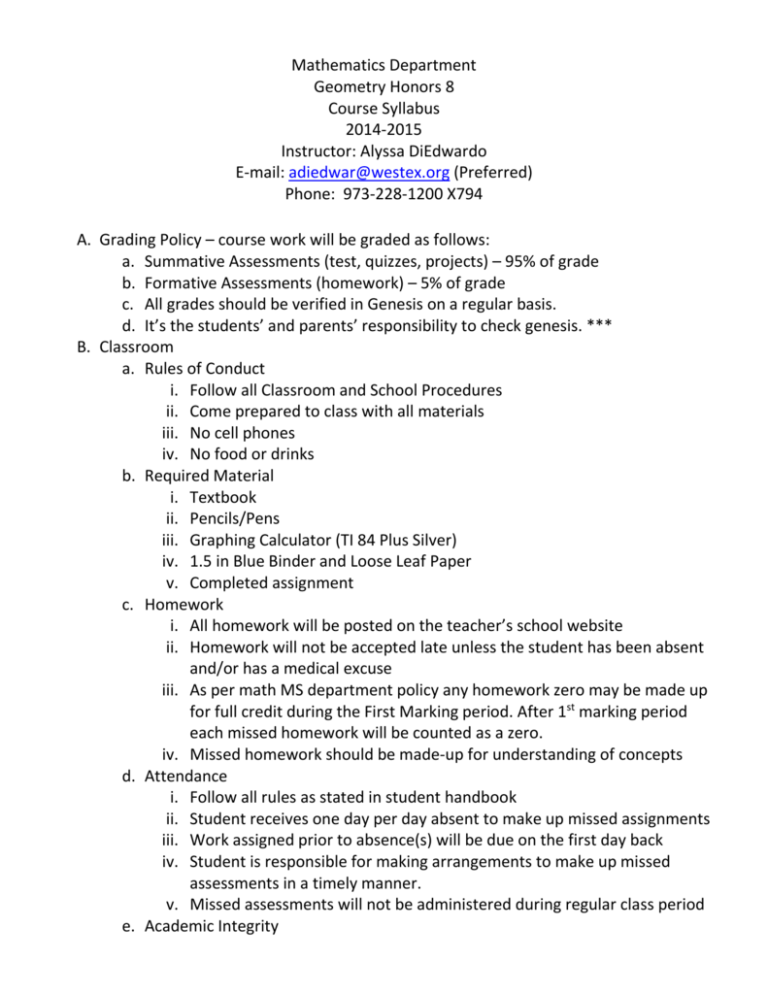
Mathematics Department Geometry Honors 8 Course Syllabus 2014-2015 Instructor: Alyssa DiEdwardo E-mail: adiedwar@westex.org (Preferred) Phone: 973-228-1200 X794 A. Grading Policy – course work will be graded as follows: a. Summative Assessments (test, quizzes, projects) – 95% of grade b. Formative Assessments (homework) – 5% of grade c. All grades should be verified in Genesis on a regular basis. d. It’s the students’ and parents’ responsibility to check genesis. *** B. Classroom a. Rules of Conduct i. Follow all Classroom and School Procedures ii. Come prepared to class with all materials iii. No cell phones iv. No food or drinks b. Required Material i. Textbook ii. Pencils/Pens iii. Graphing Calculator (TI 84 Plus Silver) iv. 1.5 in Blue Binder and Loose Leaf Paper v. Completed assignment c. Homework i. All homework will be posted on the teacher’s school website ii. Homework will not be accepted late unless the student has been absent and/or has a medical excuse iii. As per math MS department policy any homework zero may be made up for full credit during the First Marking period. After 1st marking period each missed homework will be counted as a zero. iv. Missed homework should be made-up for understanding of concepts d. Attendance i. Follow all rules as stated in student handbook ii. Student receives one day per day absent to make up missed assignments iii. Work assigned prior to absence(s) will be due on the first day back iv. Student is responsible for making arrangements to make up missed assessments in a timely manner. v. Missed assessments will not be administered during regular class period e. Academic Integrity i. Students are to hand-in their own work 1. Receiving assistance is different from copying ii. Cheating will result in a zero on the assessment and a call home to the parent f. After School Help i. Available Tuesdays, Wednesdays, Thursdays afternoon until 3:15pm. ii. If unavailable, notice will be posted in classroom and students may seek extra help from another 8th Grade Mathematics teacher C. Course Description Geometry Honors is a college preparatory courses which emphasize topics inherent to plane and solid geometry. Knowledge of geometry will be developed with an emphasis on its logical structure and problem solving with consideration of both the inductive and deductive methods of reasoning as applied to formal proofs. Students will also be introduced to probability concepts. Honors is a rigorous course with emphasis on written and constructive proof, extension topics and preparing for Calculus. D. Course Objectives a. Congruence, Proof, and Construction i. How can you use the undefined notion of a point, line, distance along a line and distance around a circular arc to develop definitions for angles, circles, parallel lines, perpendicular lines, and line segments? ii. How can you apply the definitions of angles, circles, parallel lines, perpendicular lines, and line segments to describe rotations, reflections, and translations? iii. How can you develop and perform rigid transformations that include reflections, rotations, and translations using geometric software, graph paper, tracing paper, and geometric tools, and compare them to nonrigid transformations? iv. How can you use rigid transformations to determine, explain and prove congruence of geometric figures? v. How can you create proofs of theorems involving lines, angles, triangles, and parallelograms? vi. How do you generate formal constructions with paper folding, geometric software and geometric tools? b. Similarity, Proof, and Trigonometry i. How can you verify and use the properties of dilations, use the definition of similarity to determine whether figures are similar, and establish the AA criterion using similarity? ii. How do you prove theorems about triangles and use triangle congruence and similarity to solve problems and prove relationships in geometric figures? iii. How can you develop and apply the definitions of trigonometric ratios for the acute angles of a right triangle, the relationship between the sine and cosine of complementary angles, and the Pythagorean Theorem on right triangles in applied problems? iv. How do you derive and use the formula for the area of an oblique triangle (A = 1/2 ab sin (C))? v. How do you prove and apply the Laws of Sines and Cosines to solve both right and oblique triangles? c. Extending to Three-Dimensions i. How do you develop informal arguments to justify formulas for the circumference of a circle, area of a circle, volume of a cylinder, pyramid, and cone? ii. How can you solve problems using volume formulas for cylinders, pyramids, cones, and spheres? iii. How do you identify the shape of a two-dimensional cross-section of a three-dimensional figure and identify three-dimensional objects created by the rotation of two-dimensional objects? iv. How can you use geometric shapes, their measures, and their properties to describe objects? v. How do you use density concepts in modeling situations based on area and volume? vi. How can you solve design problems using geometric methods? d. Circles and Expressing Geometric Properties through Equations i. How can you identify and describe relationships among inscribed angles, radii, and chords? ii. How do you generate proofs that demonstrate that all circles are similar? iii. How can you prove the properties of angles for a quadrilateral inscribed in a circle and construct inscribed and circumscribed circles of a triangle, and a tangent line to a circle from a point outside a circle, using geometric tools and geometric software? iv. How do you use similarity to show that the length of the arc intercepted by an angle is proportional to the radius and define the radian measure of the angle as the constant of proportionality? v. How can you derive the formula for the area of a circular sector, the equation of a circle, and the equation of a parabola? vi. How do you prove the slope criteria for parallel and perpendicular lines and use them to solve geometric problems? vii. How do you construct formal proofs using theorems, postulates, and definitions involving parallelograms? viii. How can you use the coordinate system to generate simple geometric proofs algebraically and to compute perimeters and areas of geometric figures using the distance formula? ix. How do you use geometric shapes, measures, and properties to model multi-dimensional concepts in the context of real-world applications? e. Applications of Probability i. How can you describe events as subsets of a sample space (the set of outcomes) using characteristics (or categories) of the outcomes, or as unions, intersections, or complements of other events (“or,” “and,””not”)? ii. How do you use two-way frequency tables to determine if events are independent and to calculate/approximate conditional probability? iii. How can you use everyday language to explain independence and conditional probability in real-world situations? iv. How can you find the conditional probability of A given B as the fraction of B’s outcomes that also belong to A and apply the addition and multiplication rules of probability in a uniform probability model; interpret the results in terms of the model? v. How can you use permutations and combinations to compute probabilities of compound events? vi. How do you use the concept of probability in determining fair decisions and in analysis of decisions and strategies? E. Text(s)/resources/Software: Geometry, Holt, Rinehart and Winston © 2007 TI-83/84 Plus calculator Geometer’s Sketchpad SmartBoard and its Tools (Math, Notebook and Responders) TI SmartView interactive software for TI-84
